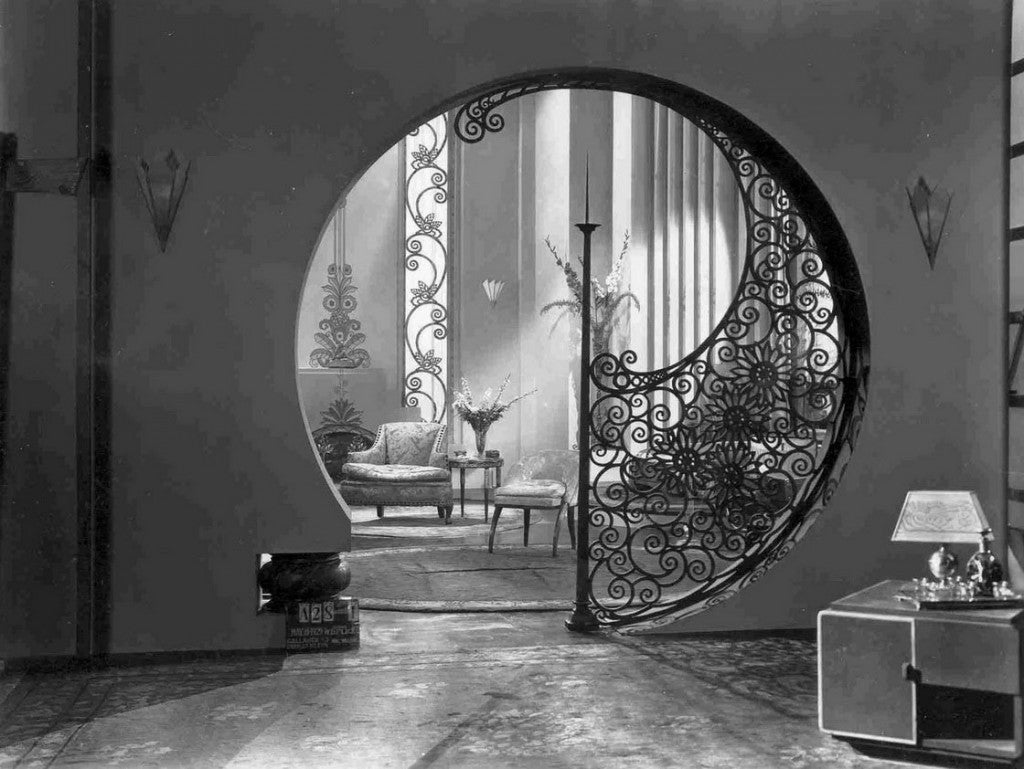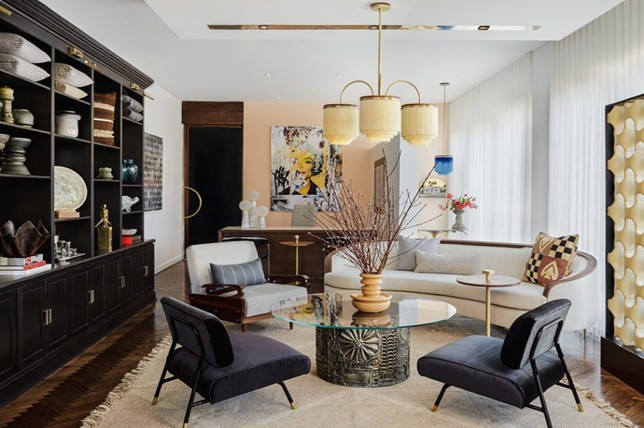Table Of Content

Large, elongated arches provide views of the New York City skyline, while gold details add a luxurious, classical feel. A dramatic wood-lined bathroom is one of many striking interiors in this penthouse in Manhattan's art deco-informed Carnegie Hill residential tower. Creating texture is not purely about how furniture and soft furnishings feel, but it's also about 'visual texture' – using different materials to add interest and breathe life into a room. So, whether you are honoring the geographical location of your home, or simply want to bring a bit of seaside serenity to your landlocked abode, these Californian home decor ideas will inspire. Justin’s preferred literary movements include modern and postmodern literature with literary fiction and genre fiction like sci-fi, post-apocalyptic, and horror being of particular interest.

Consider Marquetry-Adorned Furnishings or Walls
Zoe Saldana's glamorous Art Deco kitchen celebrates an iconic design style that is set to takeover design trends in 2024 - MSN
Zoe Saldana's glamorous Art Deco kitchen celebrates an iconic design style that is set to takeover design trends in 2024.
Posted: Sat, 06 Apr 2024 18:49:37 GMT [source]
While it's not a look for the most modest dweller, the eclectic glamour is sure to elevate even the simplest of spaces. Ahead, the inspiration you need to bring the interior exuberance of the Roaring '20s to your 21st-century space. Shop the Art Deco fixtures, wall coverings, and furniture that work wonderfully in both light and heavy doses—all of which exude levels of luxury even F.
Rockefeller Center (New York City, USA)
It originated in the 1880s and often featured forms and motifs inspired by vines, flower stems, or other natural elements. Art Deco, on the other hand, made use of straighter, geometric, and more streamlined shapes. Art Deco, which replaced Art Nouveau in the early 20th century to become the prevailing style, focused on sharp lines, geometric shapes, bold colors, luxurious materials, and the promise of technology. Skyscrapers like the Chrysler Building and the Empire State Building in New York City epitomize Art Deco style. Texture isn't a problem in the Art Deco style since it so often calls for ribbed or fluted materials. These accents—whether in the form of decorative objects like vases or lighting or built-in elements such as cabinets—add a vintage touch to your home that showcases the clean lines of this aesthetic.
Focus on Streamlined Shapes
As such, the furniture you introduce to an Art Deco living room can make all the difference to the overall aesthetic. 'Lighting is key,' says Eddie Maestri, principal architect and creative director at Maestri Studio. 'Art and sculpture pieces are another way we like to incorporate the Art Deco element in a living room.
Ways To Add Art Deco Interior Design Style To Your Home:
Doing so will create a contrast that feels complementary and totally cohesive. Molly joined the Homes & Gardens interiors team at the start of 2024 as a content editor. Her undergraduate degree was in Magazine Journalism and Production, which she studied at the University of Gloucestershire. Radio City Music Hall has long been considered a quintessential example of Art Deco interiors and architecture. Donald Deskey was hired to design the interiors, which feature terrazzo floors, marble walls, and brass ticket booths.
Paint them in a contrasting color and you have yourself an Art Deco palace. However, it's just as important to consider composition when decorating rooms. From the headboard shape to the nightstand decor, this bedroom screams Art Deco with perfect symmetry, which is a major element in Art Deco design. If you're lucky enough to live in a home with original tiling in pristine condition, do yourself a favor and keep it. Instead of renovating for something a bit more modern, play up its uniqueness by incorporating even more patterns. We also love how this predominantly pink bathroom strikes a balance via black additions on the gallery frame and curtains.
The most beautiful Art Deco buildings in Los Angeles
With a contemporary approach to a traditional design, this adds an element to the space that truly stands the test of time,' says Jessica. 'There are two ways to introduce Art Deco style into any room,' says Penny Drue Baird, principal at Dessins LLC. To better understand Art Deco—and get a few design ideas—consider both historic examples and modern interpretations designed by Lagrange and Moon. Though Moon doesn’t find his home to be a full Deco interior, the gilded walls of the sitting room certainly honor the opulent and bold elements of the style.
Designers from the Bauhaus school—which was forced to close in 1933 under Hitler’s rule—migrated to other parts of the world, including the United States, bringing with them new ideas focused on simple, functional design. Following the Great Depression, many of the original principles of Art Deco—like rich materials and opulent ornamentation—were no longer affordable and, in some situations, no longer desirable. Predating midcentury-modern aesthetics, Art Deco drew influences from Art Nouveau, the Bauhaus school, and Cubism. Tulsa, Oklahoma, and Detroit, Michigan, in particular, have impressive collections of Art Deco structures. One of our favorite things about the Art Deco style is how pattern friendly it can be. This aesthetic welcomes prints full of whimsy and lavish details that, when paired with other elements of the aesthetic, create a luxurious room.
Origins of art deco design
Book covers, blown up, make great wall art; in Art Deco, go for 1920s literature. (Movie posters and album sleeves also work for this purpose!) A gramophone in a corner, decorative or real, makes a head-turning statment, and framed 1920s newsprints or newspaper headlines bring the style home. Art Deco is a period of time that's gone by; while it's fun to think and read and sing about, the fact of the matter is that it's in the past. Most people make the period work for the modern eye by incorporating pieces of modern trends. If the style of a particular loveseat or lampshade is full-on Depression-era, balance it out with a modern complement, such as a minimalist end table or chrome lamp base.
The ornamental style evolved in the late 1920s and early 1930s, influenced by new materials and technology. Furniture, like architecture, started to have curved corners and a glossy, streamlined appearance, which was influenced by the streamlined modern aesthetic. In furniture and decorating, new materials such as chrome-plated steel, and aluminum, started appearing. Art Deco architecture rose to popularity in the 1920s and ’30s, making its way around the world from France to New York to Shanghai. The design style is known for gleaming lacquered or veneered surfaces, geometric forms, and far-flung influences from Egypt to antiquity. In this guide from AD, learn more about the opulent style, discover its fascinating history, and tour some of the world’s most beautiful Art Deco buildings in the world.
It became a genuinely cosmopolitan design in the 1920s and 1930s, with instances such as Mexico City’s Palace of Fine Arts and Tokyo’s National Diet Building. The design was most often utilized in the United States for office spaces, government facilities, theaters, and railway stations. In this section, we'll cover just a few tips and ideas to get you started on creating an elegant space inspired by the style. Leading the field in terms of ergonomics, this high-end office furniture from Buro is also designed with the evolving needs of the modern workplace in mind.
Instead of transforming your home into a shrine to the 20s and 30s, it's about tastefully infusing your space with Art Deco decor. While Art Deco is not in style the same way it used to be, that doesn’t mean there is no longer merit or beauty to the aesthetic. Generally, architecture and design historians see the start of World War II as the end of the Art Deco period, though the look had been fading for some time.
Social and architectural movements went hand in glove in making art deco a considerable success. Wherever they were, high-end social gatherings, like the Waldorf Astoria in New York City, art deco became a part of the interior design and space planning. Although this kitchen incorporates elements from traditional farmhouse decor to Art Deco designs, all the different styles work perfectly in this single space. To create a cohesive space, stick to a clear color palette and streamlined metallic finishes. 'For a living room, consider bringing in lush green paint colors, like Boreal Forest AF-480 or Vintage Vogue 462, paired with warm metallic accents to play into the decadence of Art Deco design. For a subtle nod, consider painting built-ins or furniture in these handsome hues providing the perfect backdrop for gold and brass accessories.
The art deco-informed interiors in this lookbook include ones that have been created to match the exteriors of the art deco buildings they are in, as well as interiors that draw more loosely on the style. Embrace the richness of gold, the sophistication of silver, or the warmth of brass, seamlessly weaving these luxurious finishes into your furniture, lighting fixtures, and accessories. Elaborate patterns and motifs inspired by non-Western cultures and nature make Art Deco interiors what it is. When juxtaposed with grand light fixtures such as chandeliers, sconces, and lamps, they imbue spaces with an air of timeless glamour, seamlessly offering delicate elegance. Each intricate detail, illuminated by the soft glow of these luminous accents, transports observers to escapes with understated luxury. Art deco first began to take shape in fashion, which influenced furniture designs and led to a sizeable architectural movement.
This design show was held to highlight the work of several promising young designers working in what was then called the modern style, and the movement was eventually named after this event. The trend developed during the 1925 World’s Fair in Paris, when exhibitors from all over the world were encouraged to design their pavilions in a completely new style with no historical allusions to previous movements. The 1925 Paris Exposition of Decorative Arts was the pinnacle of the style’s popularity.
Get Melissa's weekly rundown of where top interior designers source their things and find inspiration - that will instantly transform your pad. Similarly to texture, layering is another design secret that Californian interior designers swear by. The art of layering is to learn how to use each of these individually and make them work together cohesively – building a room from the ground up.

No comments:
Post a Comment